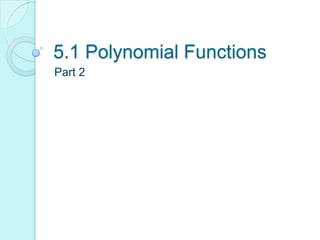Signaler
Partager

Recommandé
Contenu connexe
Tendances
Tendances (20)
Lesson 12 derivative of inverse trigonometric functions

Lesson 12 derivative of inverse trigonometric functions
Basic Calculus 11 - Derivatives and Differentiation Rules

Basic Calculus 11 - Derivatives and Differentiation Rules
General Mathematics - Intercepts of Rational Functions

General Mathematics - Intercepts of Rational Functions
Lesson 14 derivative of inverse hyperbolic functions

Lesson 14 derivative of inverse hyperbolic functions
Similaire à 5.1 part 2
Similaire à 5.1 part 2 (20)
تطبيقات المشتقات والدوال المثلثية و في الحيباة اليويمة و طرق الاشتقاق

تطبيقات المشتقات والدوال المثلثية و في الحيباة اليويمة و طرق الاشتقاق
Plus de leblance
Plus de leblance (20)
5.1 part 2
- 2. Describing the Shape of a Cubic Function 1. List the function in standard form 2. Describe the end behavior of the graph 3. Determine the possible number of turning points 4. Use a Table to plot points 5. Determine increasing and decreasing intervals
- 3. Example: Describe the Shape of a Cubic Function x y -2 -1 0 1 2
- 4. Example: Describe the Shape of a Cubic Function x y -2 -1 0 1 2
- 5. Determine the sign of the leading coefficient and the degree of the polynomial. 1. Identify the end behavior This tells you whether the leading coefficient a is positive or negative 2. Identify the number of turning points # of turning points + 1 = possible degree of the polynomial
- 6. Determine the sign of the leading coefficient and the least possible degree of the polynomial.
- 7. Determine the sign of the leading coefficient and the least possible degree of the polynomial.
- 8. Using differences to determine degree Given a table of values (or a set of ordered pairs) Analyze the differences of consecutive y – values, to determine the least-degree polynomial function that could generate the data ◦ If the first differences are constant, the function is linear ◦ If the second differences are constant, the function is quadratic ◦ If the third differences are constant, the function is cubic ◦ And so on…
- 9. Example: Determine the degree of the polynomial function with the given data.
- 10. Example: Determine the degree of the polynomial function with the given data.
- 11. Homework P 285 #32 – 39, 41 – 49all, 58